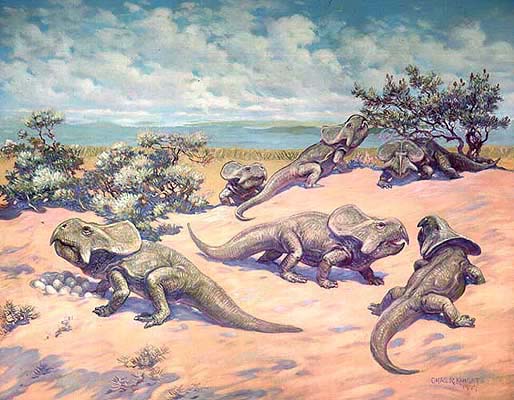 |
This is a file from the Wikimedia Commons. Information from its description page there is shown below.
Commons is a freely licensed media file repository. You can help.
|
 |
Note: This historical image is not a factually accurate dinosaur restoration.
Reason: Dragging tail, sprawling legs, nest and eggs are based on those of Oviraptor.
You may ask further questions about the accuracy of this image at the image review page of WikiProject Dinosaurs on the English Wikipedia. Note that this image may be appropriate to illustrate obsolete paleontological views.
|
Summary
| DescriptionNesting Protoceratops.jpg |
Nesting Protoceratops, Field Museum. The painting was made shortly after an expedition to Mongolia that discovered an Oviraptor nest, which was believed to have belonged to Protoceratops at the time.
|
| Date |
1922 |
| Source |
http://www.charlesrknight.com/FMNH.htm |
| Author |
Charles R. Knight |
Licensing
| Public domainPublic domainfalsefalse |
|
|
This media file is in the public domain in the United States. This applies to U.S. works where the copyright has expired, often because its first publication occurred prior to January 1, 1923. See this page for further explanation.
|
|
|
|
This image might not be in the public domain outside of the United States; this especially applies in the countries and areas that do not apply the rule of the shorter term for US works, such as Canada, Mainland China (not Hong Kong or Macao), Germany, Mexico, and Switzerland. The creator and year of publication are essential information and must be provided. See Wikipedia:Public domain and Wikipedia:Copyrights for more details. |
|
File usage
The following pages on Schools Wikipedia link to this image (list may be incomplete):
This file contains additional information, probably added from the digital camera or scanner used to create or digitize it. If the file has been modified from its original state, some details may not fully reflect the modified file.
All five editions of Schools Wikipedia were compiled by SOS Childrens Villages. SOS Children's Villages helps more than 2 million people across 133 countries around the world. You can help by sponsoring a child.




